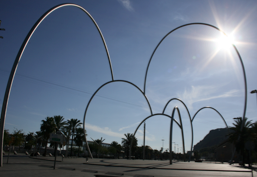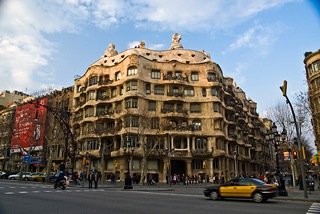Barcelona
Barcelona, Spain’s second-largest city, is a Mediterranean cruise favorite known for its architecture, lively neighborhoods, and seafront beauty. As the capital of Catalonia, Barcelona offers cruise passengers a blend of historic charm and modern vibrancy, with iconic landmarks, delicious tapas, and beaches all within easy reach of the port. Its excellent infrastructure makes it ideal for day visitors.
From the port it is about 25 minutes walk to the city center. The ships dock close to the center but you must first cross a bridge to get to the main land. At the end of the road, at the huge round-about turn right. After about 1 kilometer you will arrive at Placa de la Carbonera. At the next round-about (Placa del Portal de la Pau) cross the street and you will find yourself at the beginning of La Rambla, probably Barcelona's most popular street.

Cruise Docking Information
Barcelona is a docking port. Cruise ships arrive at the Port of Barcelona, specifically at the Adossat Quay (Terminals A, B, C, D, E, F and H) or the World Trade Center terminals for smaller vessels. The port is one of Europe’s busiest, handling over 2.5 million passengers annually. Adossat Quay is approximately 3 km (1.8 miles) from the city center and takes about 10–15 minutes by shuttle, taxi, or bus. Port facilities include tourist information desks, shuttle service, and taxis at the exit. Terminal H is new and dedicated to MSC Cruises.
Transportation Options
- Port Shuttle: The Cruise Bus connects all terminals to the Columbus Monument / WTC at the base of La Rambla (10 minutes). A small fee applies and people can choose between a one day or all day pass.
- Taxi: Available at terminal exits with a ride to central areas taking around 10–15 minutes. Taxis change a flat fee of 45€ to and from the airport.
- Public Transport: Metro stations Drassanes and Paral·lel are within walking distance from the shuttle drop-off point.
Nearby towns: Sitges (38 km / 24 miles – 45 min by train), Montserrat (60 km / 37 miles – 1 hr by train and cable car), Badalona (12 km / 7.5 miles – 30 min by metro).
Main Attractions in Barcelona
- Sagrada Família – Gaudí’s famous and still unfinished basilica.
- La Rambla – A bustling pedestrian street with shops, cafes, and street performers.
- Gothic Quarter – Narrow medieval streets with historic buildings and charming squares.
- Park Güell – A colorful park designed by Gaudí with panoramic city views.
- Barceloneta Beach – A popular beach near the city center with restaurants and sunbathing spots.
- Casa Batlló – Another Gaudí masterpiece located along Passeig de Gràcia.
- Mercat de Sant Josep de la Boqueria – A lively food market just off La Rambla.

Nearby touristic destinations
- Montserrat – A mountaintop monastery with hiking trails and views (1 hr by train and cable car).
- Sitges – A coastal town known for beaches, festivals, and a relaxed vibe (45 min by train).
- Colònia Güell – An industrial village with a Gaudí-designed crypt (35 min by train).
- Tibidabo – Offers amusement rides and stunning views over Barcelona (accessible by funicular).
Interesting Facts
- Barcelona hosted the 1992 Olympic Games, which transformed its waterfront area.
- More than 20% of the city is dedicated to green space, including parks and gardens.
- The city is home to nine UNESCO World Heritage Sites, many designed by Antoni Gaudí.
Geographical Position and Surroundings
Barcelona lies between the Mediterranean Sea and the Collserola mountain range. The city’s flat areas are easy to walk, while its hills offer impressive views. The climate is Mediterranean, with hot summers and mild winters. Its waterfront location provides access to beaches, harbors, and scenic viewpoints.
Local Foods
- Pa amb Tomàquet – Rustic bread rubbed with tomato and olive oil.
- Tapas – Small dishes like patatas bravas, anchovies, or croquettes.
- Crema Catalana – A local version of crème brûlée, flavored with citrus and cinnamon.
- Butifarra – A traditional Catalan sausage, often grilled and served with beans.
- Cava – Sparkling wine produced in Catalonia, often served with meals or as an aperitif.
Destination ‘secrets’
- Bunkers del Carmel – An off-the-beaten-path viewpoint offering panoramic city views.
- Hospital de Sant Pau – A lesser-known architectural gem and former hospital complex.
- Plaça de Sant Felip Neri – A quiet, historic square tucked within the Gothic Quarter.
Local Customs and Culture
Catalan culture is distinct and celebrated in Barcelona. While Spanish is spoken, Catalan is the co-official language, and many signs appear in both. Locals dine later in the evening, and siesta culture still influences some business hours. Festivals like La Mercè and Sant Jordi Day showcase traditional music, dancing, and parades. Politeness and awareness of local identity are appreciated.
Family-Friendly Activities
- Children up to 6 years old – Enjoy beach playtime at Barceloneta or visit the Barcelona Zoo.
- Children between 7 and 12 – Explore the CosmoCaixa science museum or ride the Montjuïc cable car.
- Teenagers aged 13 to 18 – Visit Camp Nou stadium, take a bike tour, or explore Park Güell’s artistic features.
Notice: Port information is specifically designed for cruise passengers visiting this destination. While every effort has been made to ensure accuracy, we recommend that you verify critical information such as visas, health and safety, customs, and transportation with official sources before departure. Always familiarize yourself with safety aspects when visiting your destination. We have given some pointers under the information button in the main menu of this app. Please note that distances, travel times and pricing may have some inaccuracies or may be outdated. Content and travel advice presented is created by a port moderator and/or AI. A port moderator could be a local individual, destination expert, port authority, or a tourism agency. *